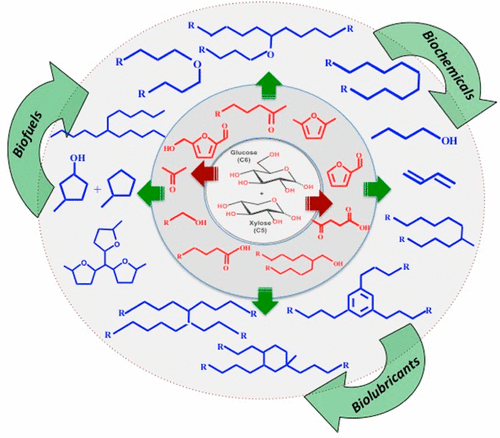当前位置:
X-MOL 学术
›
Acc. Chem. Res.
›
论文详情
Our official English website, www.x-mol.net, welcomes your feedback! (Note: you will need to create a separate account there.)
Novel Strategies for the Production of Fuels, Lubricants, and Chemicals from Biomass
Accounts of Chemical Research ( IF 18.3 ) Pub Date : 2017-09-20 00:00:00 , DOI: 10.1021/acs.accounts.7b00354 Sankaranarayanapillai Shylesh 1, 2 , Amit A. Gokhale 1, 3 , Christopher R. Ho 2 , Alexis T. Bell 1, 2
Accounts of Chemical Research ( IF 18.3 ) Pub Date : 2017-09-20 00:00:00 , DOI: 10.1021/acs.accounts.7b00354 Sankaranarayanapillai Shylesh 1, 2 , Amit A. Gokhale 1, 3 , Christopher R. Ho 2 , Alexis T. Bell 1, 2
Affiliation

|
Growing concern with the environmental impact of CO2 emissions produced by combustion of fuels derived from fossil-based carbon resources has stimulated the search for renewable sources of carbon. Much of this focus has been on the development of methods for producing transportation fuels, the major source of CO2 emissions today, and to a lesser extent on the production of lubricants and chemicals. First-generation biofuels such as bioethanol, produced by the fermentation of sugar cane- or corn-based sugars, and biodiesel, produced by the transesterification reaction of triglycerides with alcohols to form a mixture of long-chain fatty esters, can be blended with traditional fuels in limited amounts and also arise in food versus fuel debates. Producing molecules that can be drop-in solutions for fossil-derived products used in the transportation sector allows for efficient use of the existing infrastructure and is therefore particularly interesting. In this context, the most viable source of renewable carbon is abundantly available lignocellulosic biomass, a complex mixture of lignin, hemicellulose, and cellulose. Conversion of the carbohydrate portion of biomass (hemicellulose and cellulose) to fuels requires considerable chemical restructuring of the component sugars in order to achieve the energy density and combustion properties required for transportation fuels—gasoline, diesel, and jet. A different set of constraints must be met for the conversion of biomass-sourced sugars to lubricants and chemicals. This Account describes strategies developed by us to utilize aldehydes, ketones, alcohols, furfurals, and carboxylic acids derived from C5 and C6 sugars, acetone–butanol–ethanol (ABE) fermentation mixtures, and various biomass-derived carboxylic acids and fatty acids to produce fuels, lubricants, and chemicals. Oxygen removal from these synthons is achieved by dehydration, decarboxylation, hydrogenolysis, and hydrodeoxygenation, whereas reactions such as aldol condensation, etherification, alkylation, and ketonization are used to build up the number of carbon atoms in the final product. We show that our strategies lead to high-octane components that can be blended into gasoline, C9–C22 compounds that possess energy densities and properties required for diesel and jet fuels, and lubricants that are equivalent or superior to current synthetic lubricants. Replacing a fraction of the crude-oil-derived products with such renewable sources can mitigate the negative impact of the transportation sector on overall anthropogenic greenhouse gas (GHG) emissions and climate change potential. While ethanol is a well-known fuel additive, there is significant interest in using ethanol as a platform molecule to manufacture a variety of valuable chemicals. We show that bioethanol can be converted with high selectivity to butanol or 1,3-butadiene, providing interesting alternatives to the current production from petroleum. Finally, we report that several of the strategies developed have the potential to reduce GHG emissions by 55–80% relative to those for petroleum-based processes.
中文翻译:

利用生物质生产燃料,润滑剂和化学品的新策略
人们越来越关注由化石碳资源产生的燃料燃烧所产生的CO 2排放对环境的影响,这刺激了人们对可再生碳源的寻求。这些重点大多集中在生产运输燃料(CO 2的主要来源)的方法上。排放量减少了,而润滑剂和化学药品的生产量减少了。第一代生物燃料,例如通过甘蔗或玉米基糖的发酵产生的生物乙醇,以及通过甘油三酸酯与醇的酯交换反应产生的长链脂肪酯混合物的生物柴油,可以与传统燃料混合。数量有限的燃料,并且在食物与燃料的辩论中也出现了。可以作为运输领域中使用的化石衍生产品的直接解决方案的生产分子可以有效利用现有基础设施,因此特别令人感兴趣。在这种情况下,最可行的可再生碳来源是大量可用的木质纤维素生物质,木质素,半纤维素和纤维素的复杂混合物。将生物质(半纤维素和纤维素)的碳水化合物部分转化为燃料需要对成分糖进行相当大的化学重组,以实现运输燃料(汽油,柴油和喷气式飞机)所需的能量密度和燃烧特性。为了将生物质来源的糖转化为润滑剂和化学品,必须满足一系列不同的限制条件。此帐户描述了我们开发的利用源自C的醛,酮,醇,糠醛和羧酸的策略 为了将生物质来源的糖转化为润滑剂和化学品,必须满足一系列不同的限制条件。此帐户描述了我们开发的利用源自C的醛,酮,醇,糠醛和羧酸的策略 为了将生物质来源的糖转化为润滑剂和化学品,必须满足一系列不同的限制条件。此帐户描述了我们开发的利用源自C的醛,酮,醇,糠醛和羧酸的策略5和C 6糖,丙酮-丁醇-乙醇(ABE)发酵混合物以及各种生物质衍生的羧酸和脂肪酸可生产燃料,润滑剂和化学物质。通过脱水,脱羧,氢解和加氢脱氧作用,可以从这些合成子中除去氧,而醛醇缩合,醚化,烷基化和酮化等反应可用于增加最终产物中的碳原子数。我们证明了我们的策略导致可以将高辛烷值的组分混入汽油中C 9 –C 22具有柴油和喷气燃料所需的能量密度和特性的化合物,以及与目前的合成润滑剂相当或更高的润滑剂。用此类可再生资源代替部分原油衍生产品可以减轻运输部门对人为温室气体(GHG)总体排放和气候变化潜力的负面影响。尽管乙醇是众所周知的燃料添加剂,但人们非常关注使用乙醇作为平台分子来制造各种有价值的化学物质。我们表明,生物乙醇可以高选择性地转化为丁醇或1,3-丁二烯,为当前石油生产提供了有趣的替代方法。最后,
更新日期:2017-09-20
中文翻译:

利用生物质生产燃料,润滑剂和化学品的新策略
人们越来越关注由化石碳资源产生的燃料燃烧所产生的CO 2排放对环境的影响,这刺激了人们对可再生碳源的寻求。这些重点大多集中在生产运输燃料(CO 2的主要来源)的方法上。排放量减少了,而润滑剂和化学药品的生产量减少了。第一代生物燃料,例如通过甘蔗或玉米基糖的发酵产生的生物乙醇,以及通过甘油三酸酯与醇的酯交换反应产生的长链脂肪酯混合物的生物柴油,可以与传统燃料混合。数量有限的燃料,并且在食物与燃料的辩论中也出现了。可以作为运输领域中使用的化石衍生产品的直接解决方案的生产分子可以有效利用现有基础设施,因此特别令人感兴趣。在这种情况下,最可行的可再生碳来源是大量可用的木质纤维素生物质,木质素,半纤维素和纤维素的复杂混合物。将生物质(半纤维素和纤维素)的碳水化合物部分转化为燃料需要对成分糖进行相当大的化学重组,以实现运输燃料(汽油,柴油和喷气式飞机)所需的能量密度和燃烧特性。为了将生物质来源的糖转化为润滑剂和化学品,必须满足一系列不同的限制条件。此帐户描述了我们开发的利用源自C的醛,酮,醇,糠醛和羧酸的策略 为了将生物质来源的糖转化为润滑剂和化学品,必须满足一系列不同的限制条件。此帐户描述了我们开发的利用源自C的醛,酮,醇,糠醛和羧酸的策略 为了将生物质来源的糖转化为润滑剂和化学品,必须满足一系列不同的限制条件。此帐户描述了我们开发的利用源自C的醛,酮,醇,糠醛和羧酸的策略5和C 6糖,丙酮-丁醇-乙醇(ABE)发酵混合物以及各种生物质衍生的羧酸和脂肪酸可生产燃料,润滑剂和化学物质。通过脱水,脱羧,氢解和加氢脱氧作用,可以从这些合成子中除去氧,而醛醇缩合,醚化,烷基化和酮化等反应可用于增加最终产物中的碳原子数。我们证明了我们的策略导致可以将高辛烷值的组分混入汽油中C 9 –C 22具有柴油和喷气燃料所需的能量密度和特性的化合物,以及与目前的合成润滑剂相当或更高的润滑剂。用此类可再生资源代替部分原油衍生产品可以减轻运输部门对人为温室气体(GHG)总体排放和气候变化潜力的负面影响。尽管乙醇是众所周知的燃料添加剂,但人们非常关注使用乙醇作为平台分子来制造各种有价值的化学物质。我们表明,生物乙醇可以高选择性地转化为丁醇或1,3-丁二烯,为当前石油生产提供了有趣的替代方法。最后,


























 京公网安备 11010802027423号
京公网安备 11010802027423号